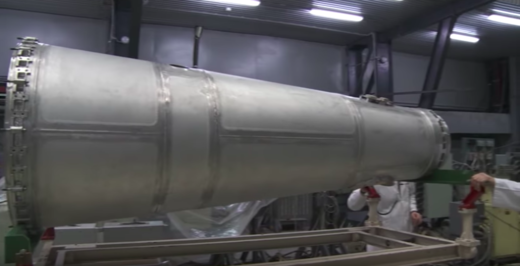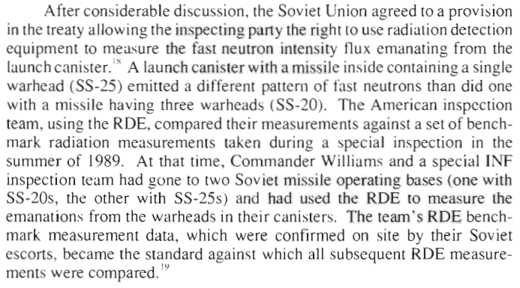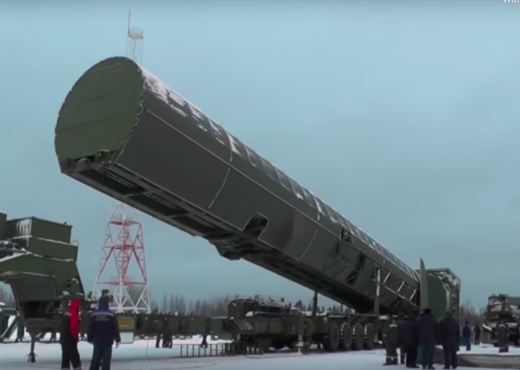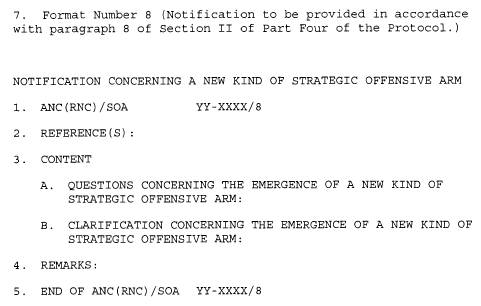We still don't know whether the United States will extend the New START Treaty. Just the other week I was told that the internal debate in the US administration is very much underway and at this point nobody can tell which way it will go. As I understand it, one the key issues on the US side is the so-called "new systems." Whether this issue is brought up in good faith is not entirely clear - nobody would be surprised if the treaty opponents would use it to sink the agreement. For them, it helps that it looks like a reasonable concern (unlike the complaints about China's not being part of the agreement).
Russia's position on the new systems is that two of them are accountable - Sarmat, which is just an ICBM, and the Avangard glider because it uses the existing and treaty-accountable UR-100NUTTH/SS-19 ICBM as a booster. As for others, Russia said it is open to a discussion under Article V of the treaty:
When a party believes that a new kind of strategic offensive arm is emerging, that Party shall have the right to raise the question of such a strategic offensive arm for consideration in the Bilateral Consultative Commission.
Russia argued, quite convincingly in my view, that the treaty in its current form covers a very specific set of systems - ICBMs, SLBMs, and heavy bombers - so including anything else would require amending the treaty, with new ratification and all that.
Russia's public assurances about Sarmat and Avangard, however, didn't seem to fully convince the United States. As I understand it, the reason was that even though Russia has been saying that these systems are covered, it hasn't formally declared them to the United States through the formal treaty channels. Until this week, that is - Russia just showed Avangard to US inspectors "in order to maintain the viability of the New START treaty."
Avangard
It's about time - it was reported earlier that the first two Adangards are about to begin combat duty in the next few weeks. As planned, the systems will be deployed at the Dombarovskiy missile division. Indeed, there was quite a bit of activity at two silos there - 51.1925 59.635278 and 51.151034 59.597282. Looks like these two are the first Avangard silos (the silo used for tests is at 51.030849 59.690144).
An interesting question is why the formal demonstration took that long. My take is that technically Russia, in fact, had no obligation to show Avangard for precisely the same reason the system is treaty-accountable. As far as the treaty is concerned, the whole thing is just a treaty-accountable UR-100NUTTH/RS-18/SS-19 ICBM with a different payload. But the treaty doesn't deal with payloads, other than confirming that the number of warheads on a missile corresponds to a declaration (there is an issue there, but more about it later). As far as I can tell, the only way Avangard would be reflected in the New START data exchange is by moving its silos from the RS-20/SS-18 column to the RS-18/SS-19 one. We don't have the Russian MOU, but I would guess that's exactly what was done with that test silo ("test launcher" in the treaty) and with these two newly converted ones.
If my reading of the treaty is correct, the Avangard demonstration was largely a gesture of goodwill designed "to maintain the viability" of the treaty. Which is a good news - Russia clearly shows that it is ready to go an extra mile to get New START extended.
UPDATE: Or maybe not. It appears that Russia declared Avangard (or at least the Avangard silo) a variant of the SS-19 missile/silo. In this case it has to hold an exhibition. Here is Part Five, Section VIII, paragraph 2 of the Protocol:
Each Party shall conduct exhibitions ... in order to demonstrate the distinguishing features and to confirm technical characteristics of each new type, variant, or version of an ICBM, SLBM, heavy bomber equipped for nuclear armaments ...
The Avangard cover
The Avangard story, however, doesn't seem to end here. We don't know the details of the demonstration, but it probably went in accordance with the established treaty procedure described in Section II of the Annex on Inspections. This is what the Annex says about the step that involves counting warheads (Paragraph 10):
The inspected Party shall have the right to cover reentry vehicles and other equipment, including the mounting platform, with individual covers, in such a manner that the covers shall not hamper inspectors in ascertaining that the front section contains a number of reentry vehicles equal to the number of reentry vehicles declared for such a deployed ICBM or deployed SLBM.
As I understand it, an RS-18/SS-19 missile with the glider would be declared as a ICBM with a single warhead. It is reasonably safe to assume that Russia covered the glider during the demonstration, probably with a soft cover of some kind. Yes, U.S. inspectors could see one object on top of the missile, but the glider seems to be pretty big, so there is no way to tell if it's the glider or a shroud that covers several regular warheads. I don't think a shroud of this size could cover all six, but there could definitely more than one.
This situation is a result of two things - the way New START counts warheads and the implicit assumptions that were made during negotiations. It wouldn't be a problem in the original START as any RS-18/SS-19 missile would be counted as carrying six warheads, big glider/shroud or not. Indeed, Russia had 30 single-warhead R-36MUTTH/RS-20B/SS-18 missiles that nevertheless counted as carrying ten warheads each. Even then, there were questions about hard covers, though - in 1995 Russia was about to formally file a complain about the hard covers used by the U.S. Navy. New START, unlike its predecessor, counts the actual number of deployed warheads. The implicit assumption, of course, was that a warhead is a conical object of a certain size. For example, the cover used during a demonstration should have "individual conically-shaped elements that cover each reentry vehicle." That doesn't quite work if the reentry vehicle is one big element, not necessarily conically shaped.
Theoretically, it should be possible to use radiation detection to confirm that there is no more than one warhead inside of that cover. But it would only work if the warheads are assumed to be nuclear (which is explicitly not the assumption made in New START - it treats nuclear and non-nuclear warheads equally). More importantly, though, there is no procedure of this kind in the treaty. Yes, radiation detection equipment can be used, but only "to demonstrate to inspectors that the objects located on the front section of an ICBM or SLBM and declared ... as non-nuclear objects, are, in fact, non-nuclear (Section II, paragraph 13 of the Annex on Inspections). The INF Treaty, in fact, had a procedure that would confirm that a missile does not carry more than one warhead. Here is an excerpt from Joseph Harahan's very detailed account (p. 145):
I don't think this procedure could be applied to the Avangard situation directly as it involves taking benchmark measurements. And, of course, it's not in New START. However, it wasn't in the original INF Treaty either - it was added in 1989, after the treaty entered into force. That was a different time, though - the chances of agreeing on something similar today are rather slim. I wouldn't completely discount them, though - from the technical point of view this all seems doable.
Sarmat
Now that Russia showed Avangard, I guess the question is, Where is Sarmat? Assuming, of course, that U.S. complaints are indeed based on the fact that Russia has not declared it through the formal treaty channels.
There are a couple of possible explanations here. Most likely, Sarmat has not yet reached the stage when it would have to be reported. Throughout the development stage the missile will probably be considered a prototype of a new type. The treaty requires its parties to provide notification "no later than five days after the arrival at a declared facility, of the first prototype ICBM or prototype SLBM of a new type" (Protocol, Part Four, Section II, paragraph 4). So far, Russia conducted three ejection tests of the missile, the first one - in December 2017. Plesetsk test site would be the "declared facility" there. But it is not entirely clear if the missile that was used in those tests could be considered an ICBM as defined in the treaty. It was not an actual ICBM, after all, but a model used in ejection tests (even though it is said to have flown "several tens of kilometers"). I don't know the answer, but it might be possible that Russia did not consider it a prototype yet, so it believed it does not have to provide the notification. On the other hand, it definitely looks like an ICBM.
Another possibility, somewhat less likely, is that Sarmat will not be declared an ICBM of new type. If its length and diameter are within three percent of those of RS-20/SS-18, the treaty, in fact, will not consider it to be a missile of a new type. The "new type" concept was inherited from START (in somewhat modified form), but it doesn't really make much sense in New START, since the key limitation - a ban on increasing the number of warheads associated with a certain type - is now gone. But it appears that the notification requirements for a variant are different and the first time it would have to be reported is probably when it is considered a deployed or non-deployed missile.
In any event, it is possible that until the first fully-functional missile is delivered to the Plesetsk test site some time in 2020 for an actual flight test, Sarmat ICBM does not really exist for the purposes of the treaty. Or I am wrong and Russia has already provided notification about Sarmat after that December 2017 test. In which case I don't quite understand where do U.S. complaints about Sarmat come from.
Other new systems
It appears that the U.S. response to this kind of reasoning is, "Well, that's two out of five." My guess is that the number five comes from adding three other systems to the equation - Kinzhal, Burevestnik, and Poseidon. I don't have much to add to the discussion around those other than to say that Kinzhal seems to be outside of any treaty definition, while Burevestnik and Poseidon are probably too far from deployment. In any event, Russia said that it is willing to discuss any new systems and New START seems to provide a good forum for that.
Just one additional note - going through the New START notification protocol I found that there is a special notification format for new arms (Section II, paragraph 7):
I hope the United States and Russia are sending some of these back and forth.
Russia's concerns
As I wrote some time ago, not everything depends on the United States. Russia has its own concerns about the treaty, mostly about the conversion procedures. In addition, my Moscow colleagues tell me that the official position is that to extend the treaty the Duma would have to pass a separate law. This will definitely complicate things, but none of this seems unsurmountable. Russia signaled its strong interest in extending New START, for a shorter period if that's what the United States wants. My guess is that if the United States agrees to extend, Russia will find a solution, maybe not dropping its concerns entirely, but agreeing to keep the discussion in the Bilateral Commission. It would certainly not want to be the party responsible for the treaty demise.





Post a comment